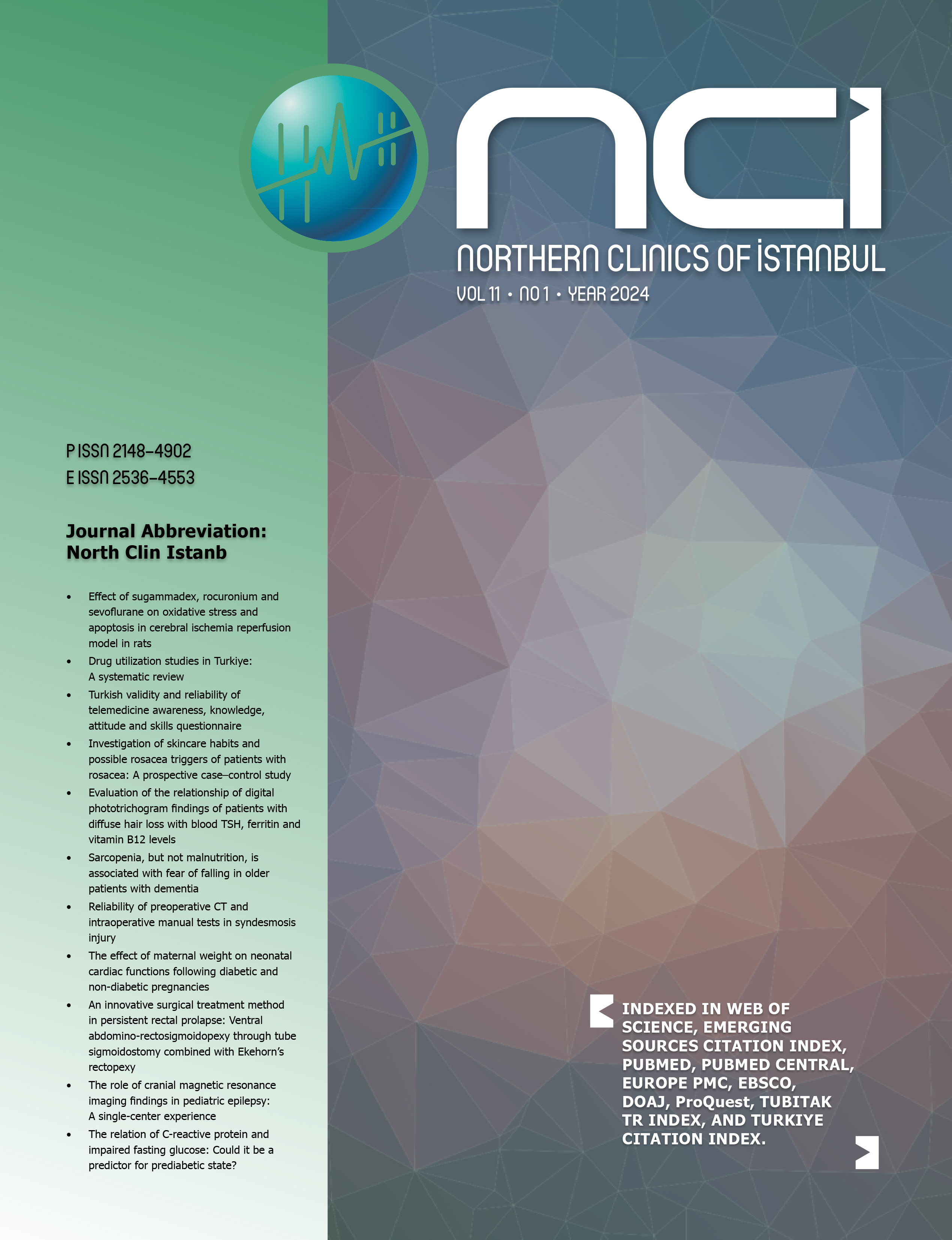A retrospective analysis of endoscopic treatment outcomes in patients with postoperative bile leakage
Süleyman Sayar1, Şehmus Ölmez2, Ufuk Avcıoğlu3, İlyas Tenlik4, Bünyamin Sarıtaş5, Kamil Özdil1, Emin Altıparmak6, Ersan Özaslan61Umraniye Education And Research Hospital, Department Of Gastroenterology, Istanbul, Turkey2Adana Numune Training And Research Hospital, Department Of Gastroenterology, Adana, Turkey
3Koru Hospital, Department Of Gastroenterology, Ankara, Turkey
4Turkiye Yuksek Ihtisas Training And Research Hospital, Department Of Gastroenterology, Ankara Turkey
5Medicalpark Hospital, Department Of Gastroenterology, Elazığ, Turkey
6Ankara Numune Training And Research Hospital. Department Of Gastroenterology, Ankara, Turkey
INTRODUCTION: Bile leakage, while rare, can be a complication seen after cholecystectomy. It may also occur after hepatic or biliary surgical procedures. Etiology may be underlying pathology or surgical complication. Endoscopic retrograde cholangiopancreatography (ERCP) can play major role in diagnosis and treatment of bile leakage. Present study was a retrospective analysis of outcomes of ERCP procedure in patients with bile leakage.
METHODS: Patients who underwent ERCP for bile leakage after surgery between 2008 and 2012 were included in the study. Etiology, clinical and radiological characteristics, and endoscopic treatment outcomes were recorded and analyzed.
RESULTS: Total of 31 patients (10 male, 21 female) were included in the study. ERCP was performed for bile leakage after cholecystectomy in 20 patients, after hydatid cyst operation in 10 patients, and after hepatic resection in 1 patient. Clinical signs and symptoms of bile leakage included abdominal pain, bile drainage from percutaneous drain, peritonitis, jaundice, and bilioma. Twelve (60%) patients were treated with endoscopic sphincterotomy (ES) and nasobiliary drainage (NBD) catheter, 7 patients (35%) were treated with ES and biliary stent (BS), and 1 patient (5%) was treated with ES alone. Treatment efficiency was 100% in bile leakage cases after cholecystectomy. Ten (32%) cases of hydatid cyst surgery had subsequent cystobiliary fistula. Of these patients, 7 were treated with ES and NBD, 2 were treated with ES and BS, and 1 patient (8%) with ES alone. Treatment was successful in 90% of these cases.
DISCUSSION AND CONCLUSION: ERCP is an effective method to diagnose and treat bile leakage. Endoscopic treatment of postoperative bile leakage should be individualized based on etiological and other factors, such as accompanying fistula.
Postoperatif safra kaçağı olan hastalarda endoskopik tedavi sonuçlarının retrospektif analizi
Süleyman Sayar1, Şehmus Ölmez2, Ufuk Avcıoğlu3, İlyas Tenlik4, Bünyamin Sarıtaş5, Kamil Özdil1, Emin Altıparmak6, Ersan Özaslan61Ümraniye Eğitim Ve Araştırma Hastanesi, Gastroenteroloji Kliniği, İ̇stanbul2Adana Numune Eğitim Ve Araştırma Hastanesi,gastroenteroloji Kliniği, Adana
3Koru Hastanesi, Gastroenteroloji Kliniği, Ankara
4Türkiye Yüksek İhtisas Eğitim Ve Araştırma Hastanesi,gastroenteroloji Kliniği, Ankara
5Medikal Park Hastanesi, Gastroenteroloji Kliniği, Elazığ
6Ankara Numune Eğitim Ve Araştırma Hastanesi, Gastroenteroloji Kliniği, Ankara
GİRİŞ ve AMAÇ: Safra kaçağı en sık kolesistektomi sonrası görülen nadir bir komplikasyondur. Ayrıca karaciğer, diğer biliyer prosedürler sonrasında altta yatan patoloji veya komplikasyona bağlı gelişir. ERCP safra kaçaklarının tanı ve tedavisinde majör rol oynar.
YÖNTEM ve GEREÇLER: 2008-2012 yılları arasında cerrahi sonrası gelişen safra kaçağı nedeni ile ERCP yapılarak tedavi edilen olgular çalışmaya dahil edildi. Etiyoloji, klinik, radyolojik özellikler ve endoskopik tedavi sonuçları kaydedildi.
BULGULAR: Çalışmaya toplam 31 hasta (10 erkek,21 kadın) dahil edildi. Hastalardan 20 tanesi kolesistektomi sonrası, 10 tanesi karaciğer kisthidatiği,1 tanesi ise hepatik rezeksiyon cerrahisi sonrası safra kaçağı gelişen olgulardı. Bu olgularda en sık semptom ve bulgular karın ağrısı, sarılık, perkütan drenden safra geleni olması, peritonit ve bilioma idi. 20 hasta (%60) endoskopik sfikterotomi (ES) ve nazobiliyer dren (NBD) ile 7 hasta (%35) ES ve biliyer stent (BS) ile bir hasta ES ile tedavi edildi. Kolesistektomi sonrası safra kaçağı gelişen olgularda tedavi başarısı %100 idi. 10 (%32) hastada kisthidatik cerrahisi sonrası kistobiliyer fistül mevcuttu. Bu hastaların 7 tanesi ES ve NBD, 2 tanesi ES ve BS ile 1 hasta ise ES ile tedavi edildi.Kistobiliyer fistül olan olgularda tedavi başarısı %90 idi.
TARTIŞMA ve SONUÇ: ERCP safra kaçaklarının teşhis ve tedavisinde kullanılan etkili bir yöntemdir.Postoperatif safra kaçaklarının endoskopik tedavisi etyolojik neden ve fistüle eşlik eden diğer faktörlere göre bireyselleştirilmelidir.
Corresponding Author: Süleyman Sayar, Türkiye
Manuscript Language: English






















